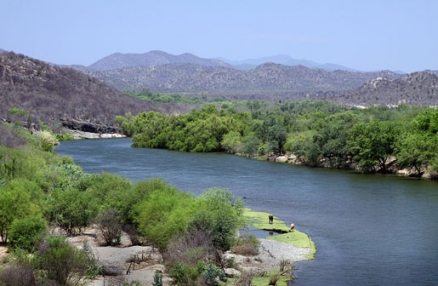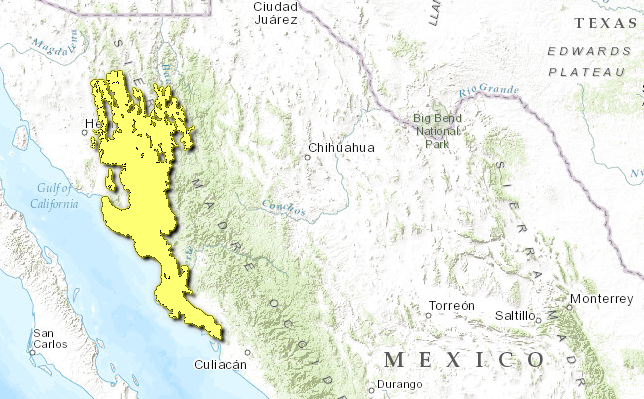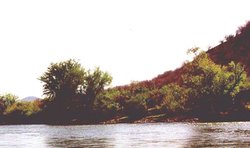Sonoran-Sinaloan transition subtropical dry forest
The Sonoran-Sinaloan transition subtropical dry forest ecoregion comprises a distinct zone of dry forest that forms a north-south transition between the Sonoran Desert to the north and the Sinaloan dry forests to the south. The Sonoran-Sinaloan transition subtropical dry forest ecoregion shares elements of climate, as well as soil and topographic attributes, with both neighbouring ecoregions.The subject ecoregion also comprises part of a much broader ecological unit: the Tropical and Subtropical Dry Broadleaf Forests biome. The southeastern ecoregion boundary marks the end of the Nearctic and the beginning of the Neotropical biogeographic realm.
Nonetheless, the Sonoran-Sinaloan transition subtropical dry forest manifests an interesting mixture of temperate and tropical biota, many species of which find either their northern or southern limits here. There is a generally low faunal endemism and faunal species richnesss; for example, only 310 vertebrates species are found in the ecoregion, with a notable lack of amphibians and reptiles present. Characteristically tropical species include the magnificent Black-throated Magpie Jay (Calocitta colliei). On the other hand, many more typically northern desert species are also found here, including Jumping Cholla cactus (Opuntia fulgida) and Fish-hook Barrel Cactus (Ferocactus wisliznei).
Location and general depiction
The Sonoran-Sinaloan ecoregion is contained totally in Mexico, from the Pacific coastal zone of the states of Sonora and Sinaloa, and north into the foothills of the Sierra Madres Occidental of central Sonora. Bio-climatically, the ecoregion is classified as a dry steppe life-zone, in contrast to the more humid seasonal forests to the south, and arid deserts to the north. Like neighboring regions, rainfall predominates in the summers. Annual rainfall is approximately 10-20 cm. Because of its proximity to the coast, fluctuations in annual temperatures are only on the order of 10-15° C (difference between median monthly high and low temperature). Frost and temperatures below freezing are rare, in contrast to the Sonoran Desert, to the north. Unlike the distinctly xeric desert vegetation to the north, and the tropical deciduous forest to the south, the vegetation of the Sonoran-Sinaloan transition dry forest is dominated by a deciduous thorn forest or selva espinosa. Pockets of semiarid mattoral as well as thorn scrub are also present.
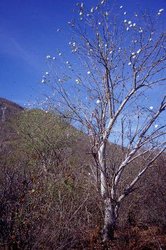 Near Los Mochis, Mexico. Source: David Olson Topography is quite variable in this ecoregion. Elevation ranges from approximately sea level near coastal mangroves to roughly 2000 metres (m) in the foothills of the Sierra Nevada. Moving north and east, relatively flat coastal areas give way to rolling country with arroyos. Steep canyons, cliffs, and waterfalls characterize the foothills of the sierras. Similarly, geomorphology varies from a low-gradient slope along the alluvial coastal plain, composed primarily of unconsolidated sediments to steeper gradients of acidic rocks of igneous origin and clastic sediments as one moves up into the mountains.
Near Los Mochis, Mexico. Source: David Olson Topography is quite variable in this ecoregion. Elevation ranges from approximately sea level near coastal mangroves to roughly 2000 metres (m) in the foothills of the Sierra Nevada. Moving north and east, relatively flat coastal areas give way to rolling country with arroyos. Steep canyons, cliffs, and waterfalls characterize the foothills of the sierras. Similarly, geomorphology varies from a low-gradient slope along the alluvial coastal plain, composed primarily of unconsolidated sediments to steeper gradients of acidic rocks of igneous origin and clastic sediments as one moves up into the mountains.
Dominant trees in this forest include many species from the families Acaciaceae, Burseraceae and Leguminosae. Cacti, such as Organ Pipe Cactus (Stenocereus thurberi), are often conspicuous and abundant. Overall, this dry forest is less pronounced and more seasonal than its southern cousin, particularly as one moves north to the margins of the Sonoran Desert. Common and characteristic plants include several acacias: Boat-thorned Acacia (Acacia cochliacantha); and Sonoran Tree Catclaw or Tésota (Acacia occidentalis). The former, a shrub, or small tree, is the only local acacia with boat-shaped thorns. The latter acacia flowers prolifically in March, perfuming the air so heavily that it can often be sensed by scent before it is seen. Another common species in the thorn forest is Torote Prieto (Bursera fragilis). The gum of B. fragilis has been utilised for treating stings of scorpions and other insects, as well as for mending pottery. Northern limits for many characteristic species of this region appear to be strongly influenced by low winter temperatures and decreasing summer precipitation.
Biodiversity characteristics
In general, Mexican dry forests have the highest levels of plant endemism of all Neotropical dry forests. Twenty percent of Mexico’s vascular plant species (approximately 6000 species) occur in tropical dry forests, more than the contribution of Mexico’s tropical humid forests, or deserts. Although precise figures are not available, this region also supports a number of endemic and rare plants, including the arborescent morning glory or palo santo (Ipomea arborescens). This species flowers in the dry season, thus providing pollen to nectar-feeding long-tongued bats (Choeronycteris mexicana and Glossophaga soricina) – amongst the most important pollinators of the Sonoran region – at a time when few other plants are in flower.
When the ping-pong-ball-like flowers fall to the ground they are browsed upon by White-tailed Deer (Odocoileus virginianus). The botanist Howard Gentry reported 33 to 45 species in one-half acre of undisturbed forest, which is relatively rich for a tropical dry forest so close to the temperate zone. Overall plant richness rivals that of the Sonoran Desert to the north. The ecoregion is also home to as many as 90 species of butterfly during the rainy season. This ecoregion is also notable as the northern limit for many neotropical plant families.
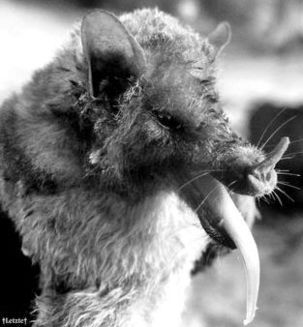 Mexican Long-tongued Bat. Source: iNaturalist/ EoL Mammals
Mexican Long-tongued Bat. Source: iNaturalist/ EoL Mammals
A number of mammalian taxa are found in this arid ecoregion, among them the following special status taxa; Margay (Leopardus wiedii NT); Mexican Big-eared Bat (Plecotus mexicanus NT); Mexican Long-tongued Bat (Choeronycteris mexicana NT); and the Lesser Long-nosed Bat (Leptonycteris yerbabuenae VU).
Birdlife
Within the ecoregion, several areas have been identified as important areas for bird conservation, including the large Cuenca del Río Yaqui. In addition, CONABIO has identified a number of terrestrial priority areas within the ecoregion, including Marismas Topolobampo-Caimanero and San Javier-Tepoca, each of which are about 4000 square kilometres.
Ecological status
Although throughout extensive areas, such as along the upper Rio Cuchujaqui, over half of the original forest has been cleared (Deforestation), extensive blocks of intact dry forest may remain, particularly on the steep, uncultivable margins of the mountains. There is evidence that these continue to support large carnivores and intact mammalian faunas. Habitat along the coastal plain has been heavily altered and degraded. The overall distribution of intact habitat in this ecoregion is unknown, due in part to the difficulty using remote sensing to accurately map intact dry forest. In general, however, dry forests have virtually disappeared from Central America. Of the approximately two percent of dry forest that remains intact in the entire Central America region, this area supports some of the largest remaining tracts. There are no formally protected areas in the ecoregion.
Ecological threat profile
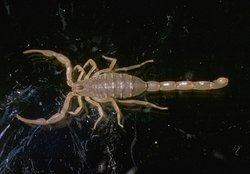 Scorpion species, near Guaymas, Sonora, Mexico (Photograph by Dr. Antonio J. Ferreira, California Academy of Sciences & CalPhotos) Agriculture, ranching, development for tourism, sport and subsistence hunting, are the primary threats toall Mexican dry forests. The primary threat here is cattle ranching – particularly when it involves the complete removal of the original vegetation and the planting of buffel and other non-native grasses. In twenty years between the 1970’s and the 1990’s, vast tracts of forest between the cities of Navojoa and Alamos were cut down by hand or bulldozer, burned, and replaced with non-native buffel grass. There is hope for restoration, however. Twelve to twenty years after clearing, the majority of original woody species are again evident. Low-level subsistence hunting and conversion for agriculture are lesser threats. Increasing temperatures due to human-caused climate change (Causes of climate change) pose a serious threat given the transitional nature of the ecoregion, and the narrow temperature and precipitation requirements of many of its native species. Comprehensive conservation strategies for this and other Mexican dry forests are urgently needed.
Scorpion species, near Guaymas, Sonora, Mexico (Photograph by Dr. Antonio J. Ferreira, California Academy of Sciences & CalPhotos) Agriculture, ranching, development for tourism, sport and subsistence hunting, are the primary threats toall Mexican dry forests. The primary threat here is cattle ranching – particularly when it involves the complete removal of the original vegetation and the planting of buffel and other non-native grasses. In twenty years between the 1970’s and the 1990’s, vast tracts of forest between the cities of Navojoa and Alamos were cut down by hand or bulldozer, burned, and replaced with non-native buffel grass. There is hope for restoration, however. Twelve to twenty years after clearing, the majority of original woody species are again evident. Low-level subsistence hunting and conversion for agriculture are lesser threats. Increasing temperatures due to human-caused climate change (Causes of climate change) pose a serious threat given the transitional nature of the ecoregion, and the narrow temperature and precipitation requirements of many of its native species. Comprehensive conservation strategies for this and other Mexican dry forests are urgently needed.
Justification of Ecoregion Delineation
This xeric dry forest ecoregion represents the transition from desert (to the north) to dry forest (to the south). As mentioned above, the northern and southern limits of many species occur here. Initial linework follows the current land-cover classifications of INEGI and reviews of linework were conducted at several ecoregion priority setting workshops. From this map we lumped the following classifications: "lowland spine forests", "lowland caducifolous forests", "sarcocaulous matorral", "pachycaulous matorral", "microphyll desert matorral", all subsequent agricultural areas, and "halophilic vegetation" along the coast. Later modification occurred from expert opinions, following suggestions from Rzedowski and others at a regional ecoregion delineation workshop.
Further Reading
- L. Arriaga, J.M. Espinoza, C. Aguilar, E. Martínez, L. Gómez y E. Loa. 2000. Regiones terrestres prioritarias de México. Escala de trabajo 1:1 000 000. Comisión Nacional para el Conocimiento y uso de la Biodiversidad. México.
- H. Benitez, C. Arizmendi, y L. Marquez, L. 1999. Base de datos de las AICAS. CIPAMEX, CONABIO, FMCN, y CCA. México.
- Bowden. 1993. The Secret Forest. University of New Mexico Press, Albuquerque.
- G. Ceballos and A. García. 1995. Conserving neotropical diversity: The role of dry forests in Western Mexico. Conservation Biology 9:6 (1349-1356).
- A. Challenger. 1998. Utilización y Conservatción de los Ecosistemas Terrestres de México. Pasado, Presente y Futuro.
- CONABIO Workshop, 17-16 September, 1996. Informe de Resultados del Taller de Ecoregionalización para la Conservación de México.
- CONABIO Workshop, Mexico, D.F., November 1997. Ecological and Biogeographical Regionalization of Mexico
- Davis, S.D., V.H. Heywood, O. Herrera MacBryde, J. Villa-Lobos and A.C. Hamilton, editors. 1997. Centres of Plant Diversity. A Guide and Strategy for their Conservation. Volume 3. The Americas. IUCN Publications Unit, Cambridge, U.K. 562 pp.
- FAO 1998. Soil and Terrain Database for Latin America and the Carribean - 1:5 Million scale, FAO, Land and Water Digital Media Series n°5, Food and Agriculture Organization, Rome, Italy.
- Gentry, A.H. 1995. Diversity and composition of neotropical dry forests. In: Seasonally dry tropical forests. S.H. Bullock, H.A. Mooney, and E. Medina, editors. Cambridge University Press, Cambridge. ISBN: 0521435145
- INEGI Map (1996) Comision Nacional Para el Conocimiento y Uso de la Biodiversidad (CONABIO) habitat and land use classification database derived from ground truthed remote sensing data Insitituto Nacional de Estastica, Geografia, e Informática (INEGI). Map at a scale of 1:1,000,000.
- Instituto de Geographía. 1990. Atlas nacional de México. Instituto de Geographía. UNAM. México.
- Rzedowski, J. 1994. Vegetactión de México. Limusa Noriega Editores. México, D.F.
- Rzedowski, J. pers.comm. at CONABIO Workshop, 17-16 September, 1996. Informe de Resultados del Taller de Ecoregionalización para la Conservación de México.
- Strattersfield, A.J., M.J. Crosby, A.J. Long, and D.C. Wege. 1998. Endemic Bird Areas of the World: Priorities for Biodiversity Conservation. BirdLife International, Cambridge, UK. ISBN: 0946888337
- Turner, R. M., J.E. Bowers, and T.L. Burgess, 1995. Sonoran Desert Plants: An Ecological Atlas. University of Arizona Press, Tuscon. ISBN: 0816525196
| Disclaimer: This article contains certain information that was originally published by the World Wildlife Fund. Topic editors and authors for the Encyclopedia of Earth have edited its content and added new information. The use of information from the World Wildlife Fund should not be construed as support for or endorsement by that organization for any new information added by EoE personnel, or for any editing of the original content. |
